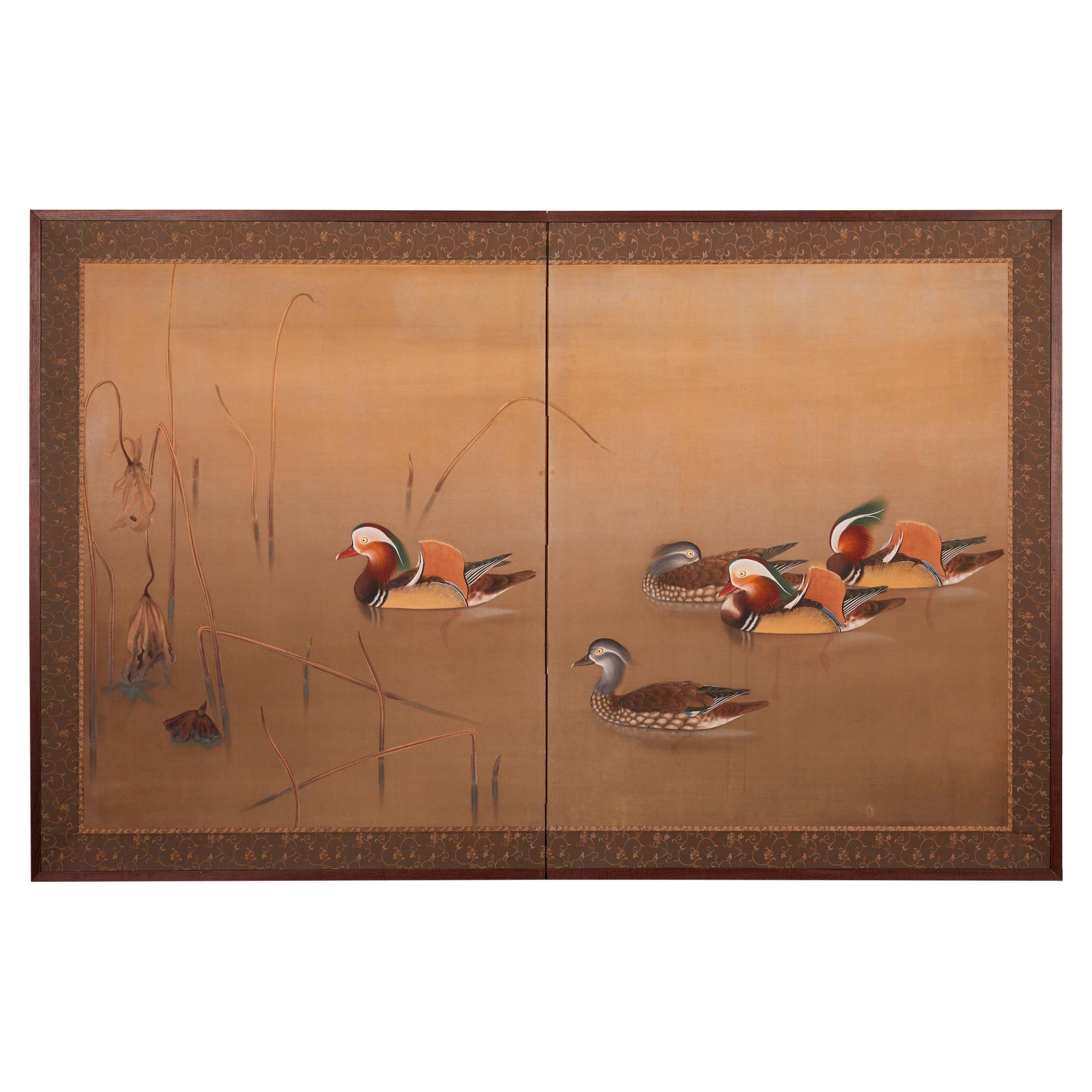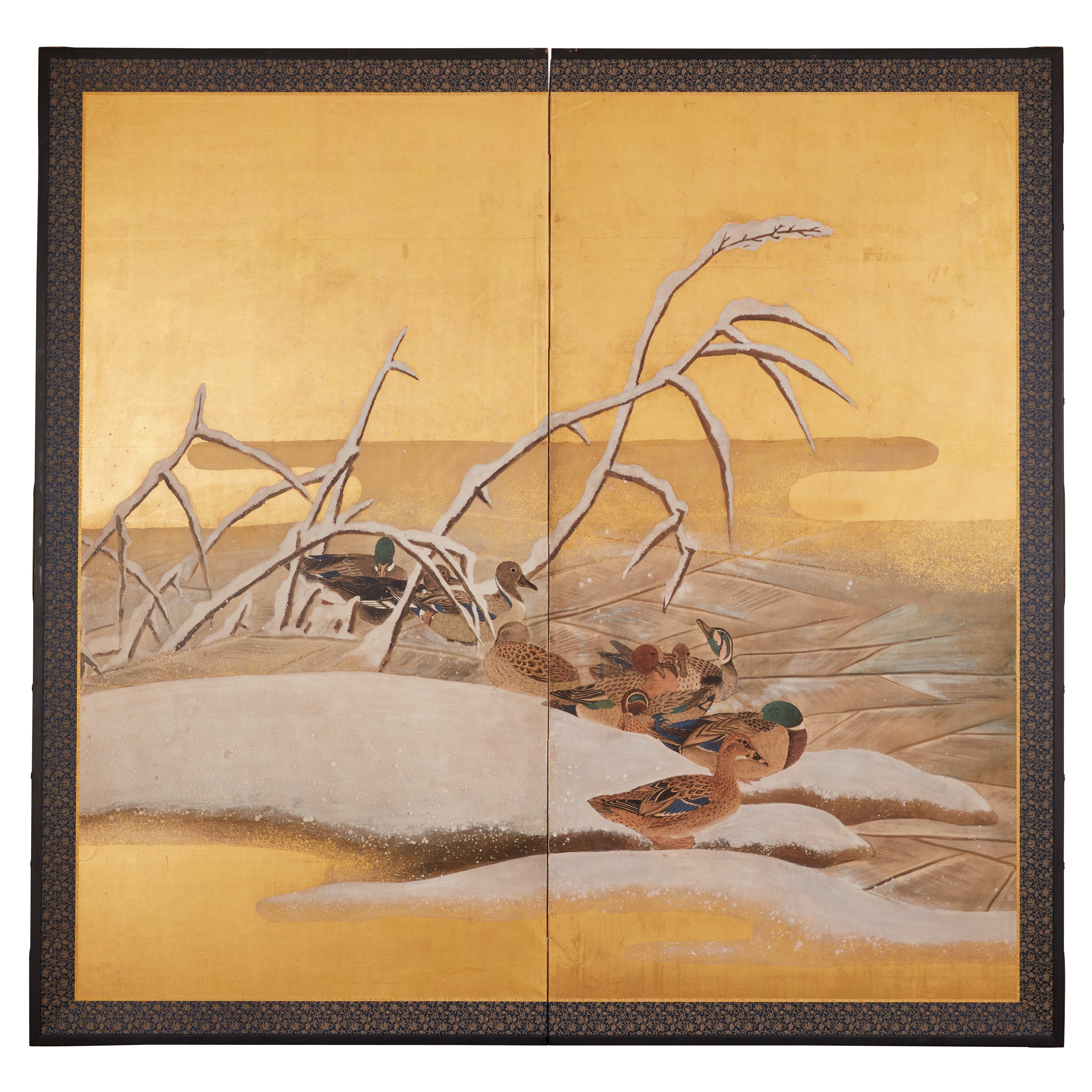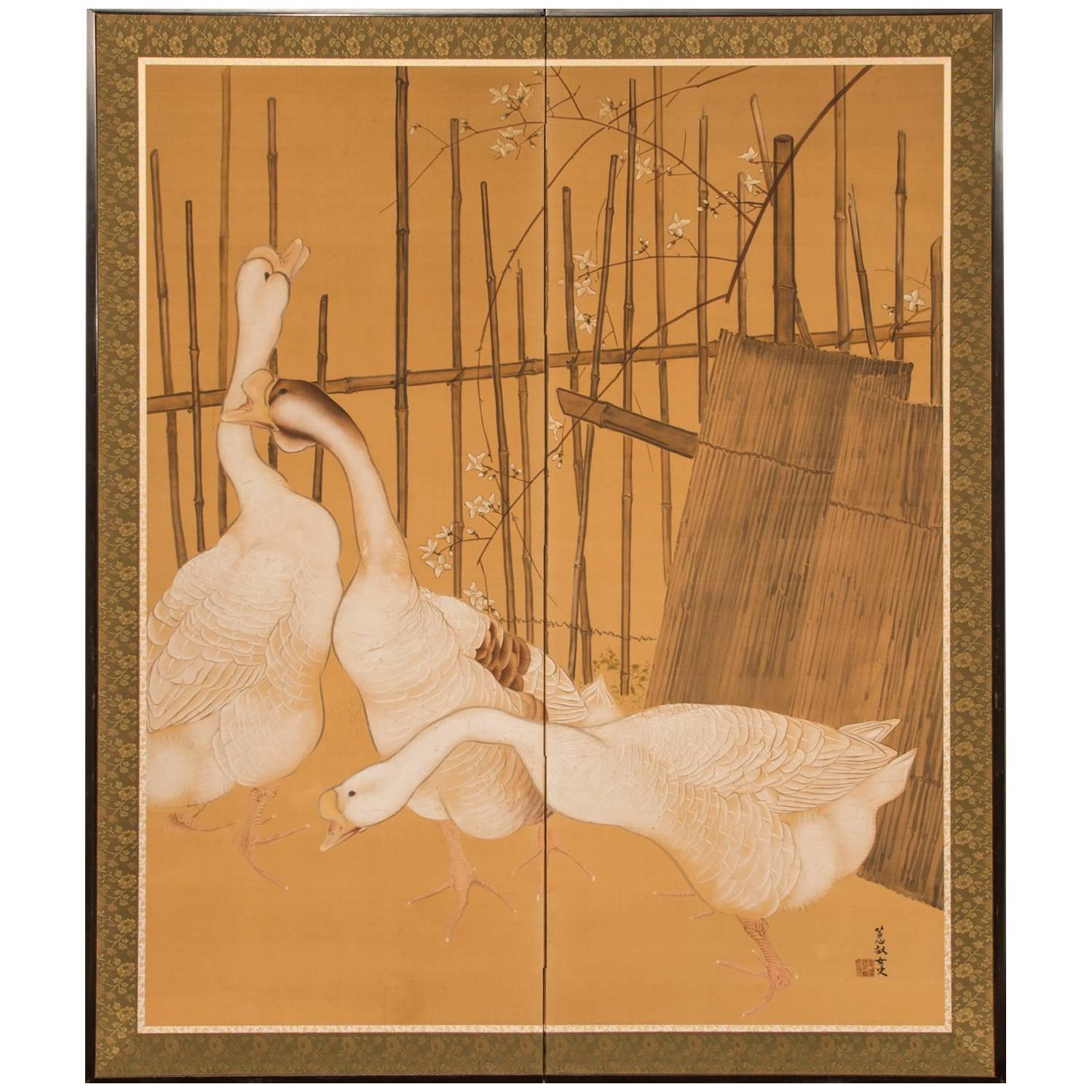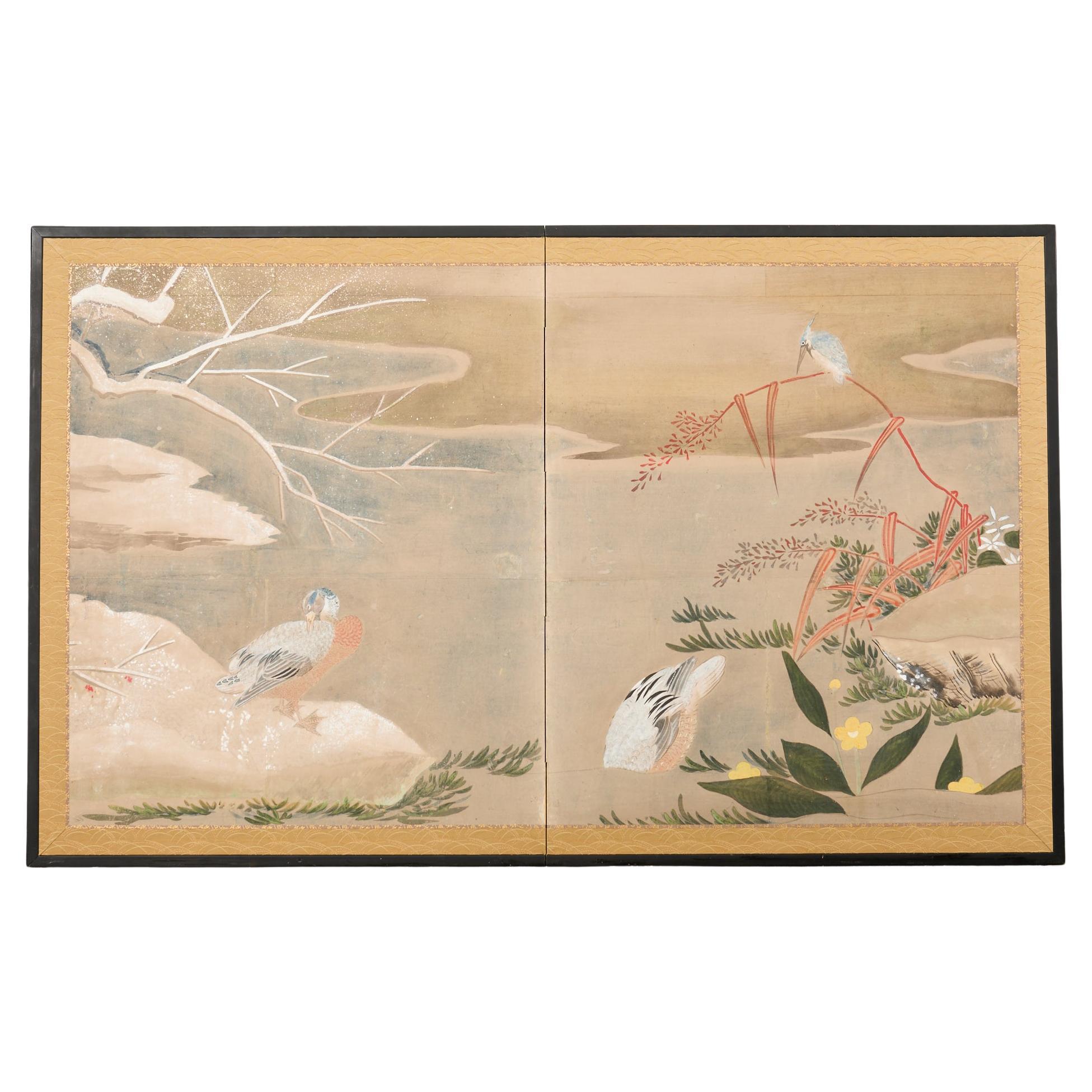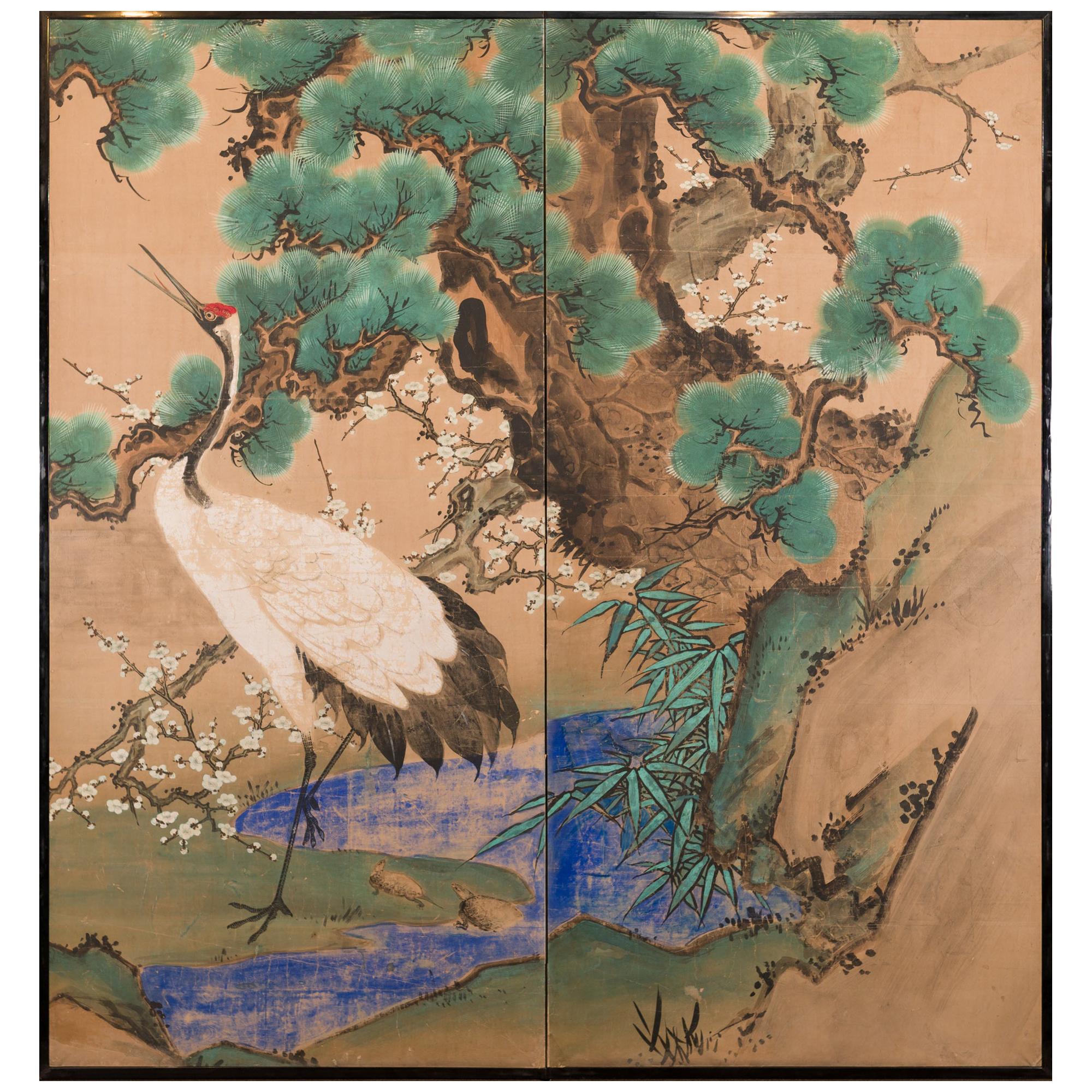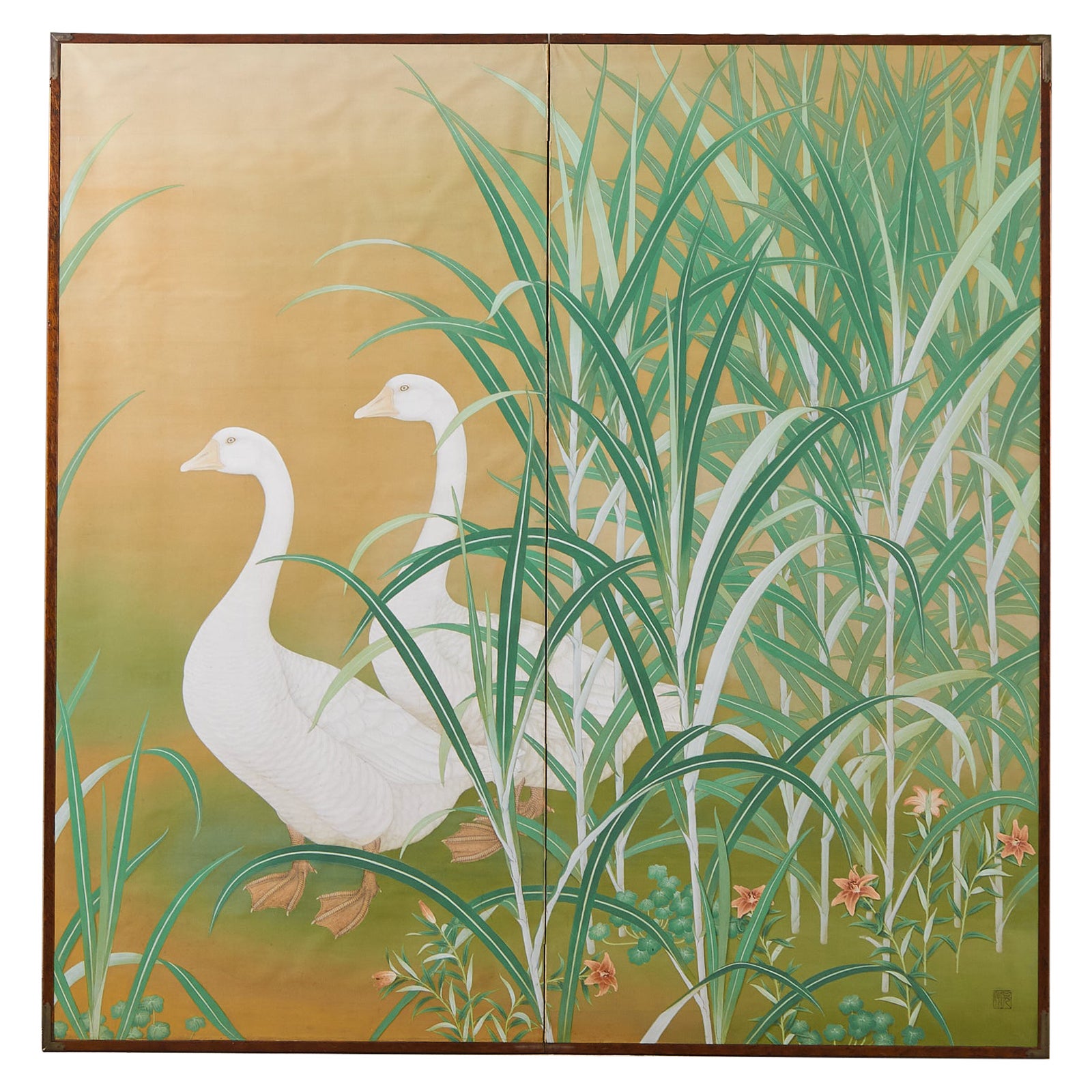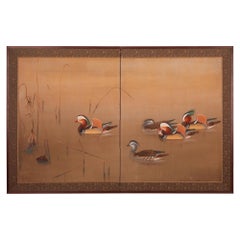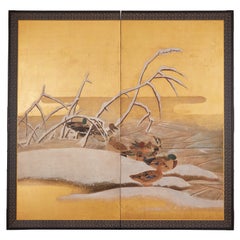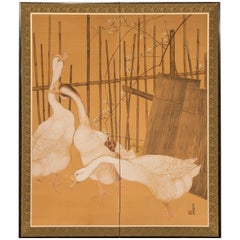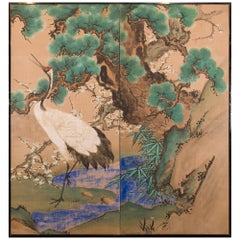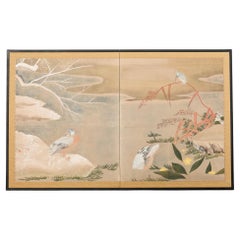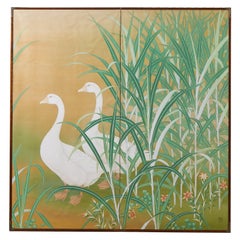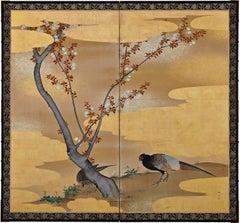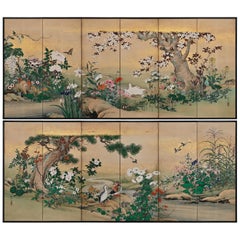Items Similar to Japanese Two Panel Screen: Mandarin Ducks and Geese Among Bamboo and Flowers
Want more images or videos?
Request additional images or videos from the seller
1 of 6
Japanese Two Panel Screen: Mandarin Ducks and Geese Among Bamboo and Flowers
$15,000
£11,381.65
€13,013.90
CA$20,950.93
A$23,294.59
CHF 12,163.15
MX$283,551.84
NOK 155,196.47
SEK 145,411.67
DKK 97,125.17
Shipping
Retrieving quote...The 1stDibs Promise:
Authenticity Guarantee,
Money-Back Guarantee,
24-Hour Cancellation
About the Item
Japanese Two Panel Screen: Mandarin Ducks and Geese Among Bamboo and Flowers, Edo period painting (c. 1850) of mandarin ducks and geese on a grassy shoreline with bamboo and white camellia flowers. A beautiful early painting with heavy gold dust clouds, and soft pigments on mulberry paper with a silk brocade border. Great condition.
- Dimensions:Height: 37.88 in (96.22 cm)Width: 44.5 in (113.03 cm)Depth: 0.75 in (1.91 cm)
- Style:Edo (Of the Period)
- Materials and Techniques:
- Place of Origin:
- Period:
- Date of Manufacture:circa 1850
- Condition:Condition report available upon request.
- Seller Location:Hudson, NY
- Reference Number:Seller: S14921stDibs: LU85513014112
About the Seller
5.0
Recognized Seller
These prestigious sellers are industry leaders and represent the highest echelon for item quality and design.
Established in 1971
1stDibs seller since 2008
166 sales on 1stDibs
Typical response time: 10 hours
Associations
The Art and Antique Dealers League of AmericaAntiques Associations Members
- ShippingRetrieving quote...Shipping from: Craryville, NY
- Return Policy
Authenticity Guarantee
In the unlikely event there’s an issue with an item’s authenticity, contact us within 1 year for a full refund. DetailsMoney-Back Guarantee
If your item is not as described, is damaged in transit, or does not arrive, contact us within 7 days for a full refund. Details24-Hour Cancellation
You have a 24-hour grace period in which to reconsider your purchase, with no questions asked.Vetted Professional Sellers
Our world-class sellers must adhere to strict standards for service and quality, maintaining the integrity of our listings.Price-Match Guarantee
If you find that a seller listed the same item for a lower price elsewhere, we’ll match it.Trusted Global Delivery
Our best-in-class carrier network provides specialized shipping options worldwide, including custom delivery.More From This Seller
View AllJapanese Two Panel Screen: Mandarin Ducks Among Dry Lotus
Located in Hudson, NY
Natural scene of Mandarin ducks gliding gracefully amongst the water.
Mineral pigments on silk with silk brocade border and natural wood trim. Seal reads: Kei.
Category
Early 20th Century Japanese Paintings and Screens
Materials
Silk, Wood
Japanese Two Panel Screen: Mandarin Ducks in Winter
Located in Hudson, NY
Fine painting of a variety of waterfowl in rich mineral pigments on gold leaf with a silk brocade border.
Category
Antique 19th Century Japanese Paintings and Screens
Materials
Gold Leaf
Japanese Two-Panel Screen: Geese in a Country Setting
Located in Hudson, NY
Country farm geese with early spring blossoms and a bamboo fence. Beautiful details on the feathers. Signature and seal read Keibo Joshi (Ms. Keibo) min...
Category
Early 20th Century Japanese Meiji Paintings and Screens
Materials
Silk, Wood, Paper
Japanese Two Panel Screen Manchurian Crane and Turtles
Located in Hudson, NY
In Japan, cranes symbolize fidelity as they mate for life and turtles symbolize longevity. Additionally, this screen also has the Japanese motif of sho-chiku-bai, or the three friends of winter (pine, plum, and bamboo). So called the three friends of winter because all three flourish during the cold months. This screen was originally fusuma doors...
Category
Antique Mid-19th Century Japanese Edo Paintings and Screens
Materials
Paper
Japanese Two Panel Screen Amorous Cranes and Turtles
Located in Hudson, NY
Japanese two panel screen: Amorous Cranes and Turtles. In Japan, cranes symbolize fidelity as they mate for life and turtles symbolize longevity. Additionally, this screen also has the Japanese motif of sho-chiku-bai, or the three friends of winter (pine, plum, and bamboo). So called the three friends of winter because all three flourish during the cold months. This screen was originally fusuma doors...
Category
Antique 1850s Japanese Edo Paintings and Screens
Materials
Wood, Paper
Japanese Two Panel Screen: Water Fowl by River's Edge
Located in Hudson, NY
Japanese Two Panel Screen: Water Fowl by River's Edge, Showa period (1926 - 1989) painting of fowl on a river bank. Very art deco in style. Painted in min...
Category
Early 20th Century Japanese Showa Paintings and Screens
Materials
Silk, Wood, Paper
You May Also Like
Japanese Showa Two Panel Screen Ducks in Winter Landscape
Located in Rio Vista, CA
Serene Japanese Showa period two panel byobu screen featuring two ducks and kingfisher in a late fall/early winter landscape. Crafted with ink and natural pigment colors on hand-craf...
Category
20th Century Japanese Showa Paintings and Screens
Materials
Silk, Wood, Paper
Japanese Meiji Two Panel Screen Geese and Reeds
Located in Rio Vista, CA
Fantastic Japanese late Meiji period two-panel byobu screen by Hashimoto Koshu. The large screen features two white geese amid brightly colored reeds. The symbolism of geese and reeds was introduced to Japan from China in the 13th century. This was a popular subject for Japanese zen artists of the period. Beautifully crafted with exceptional brush strokes and details. Made with natural pigments in dramatic vivid colors of white, pink, and mint green on a silk background of gilt. Circa 1900 with artist seal on bottom right corner. Koshu studied Western art under...
Category
20th Century Japanese Meiji Paintings and Screens
Materials
Silk, Wood, Paper
Early 19th Century Japanese Screen. Cherry Blossom & Pheasants by Mori Tetsuzan
Located in Kyoto, JP
Mori Tetsuzan (1775-1841)
Pheasants and Cherry Blossoms
Two-fold Japanese screen. Ink, color, gofun, gold and silver on paper.
A two-fold Japanese bir...
Category
Antique Early 19th Century Japanese Edo Paintings and Screens
Materials
Gold Leaf
19th Century Japanese Screen Pair. Flowers & Birds of the Four Seasons
Located in Kyoto, JP
Flowers & Birds of the Four Seasons
Pair of six-fold Japanese Screens. Ink, color, gofun and gold on paper.
Second half of the 19th Centur...
Category
Antique Late 19th Century Japanese Meiji Paintings and Screens
Materials
Wood, Paper
Antique Japanese Four Panel Byobu Screen: Mandarin Ducks by Snowy Pond in Early
Located in Sheridan, CO
Antique Japanese Four Panel Byobu Screen: Mandarin Ducks by Snowy Pond in Early Spring.
Kano School painting of a weeping willow tree with branches over a stunning indigo blue pond. ...
Category
Early 20th Century Meiji Paintings and Screens
Materials
Metal, Gold Leaf
17th Century Japanese Screen. Cranes and Peonies. Edo period.
Located in Kyoto, JP
Cranes and Peonies
Anonymous, Kano School.
Edo period, second half of the 17th century.
Six-panel Japanese screen. Ink, pigment gofun and gold leaf on paper.
This Japanese screen...
Category
Antique Mid-17th Century Japanese Edo Paintings and Screens
Materials
Gold Leaf
More Ways To Browse
Antique Ducks
Japanese Screen Bamboo
Bamboo Screen Mid Century
Japanese Screens Flowers
Edo Screen Gold
Painting On Wood Bamboo
Wood Ducks
Japanese Silk Screen Flowers
Antique Wood Ducks
Wood Geese
Two Geese
Asian Screen Ducks
Traditional Japanese Painting
Vintage Asian Painting
Mid Century Chinese Screen
Chinese Carved Screen
Japanese Crane
Japanese Silk Panel
